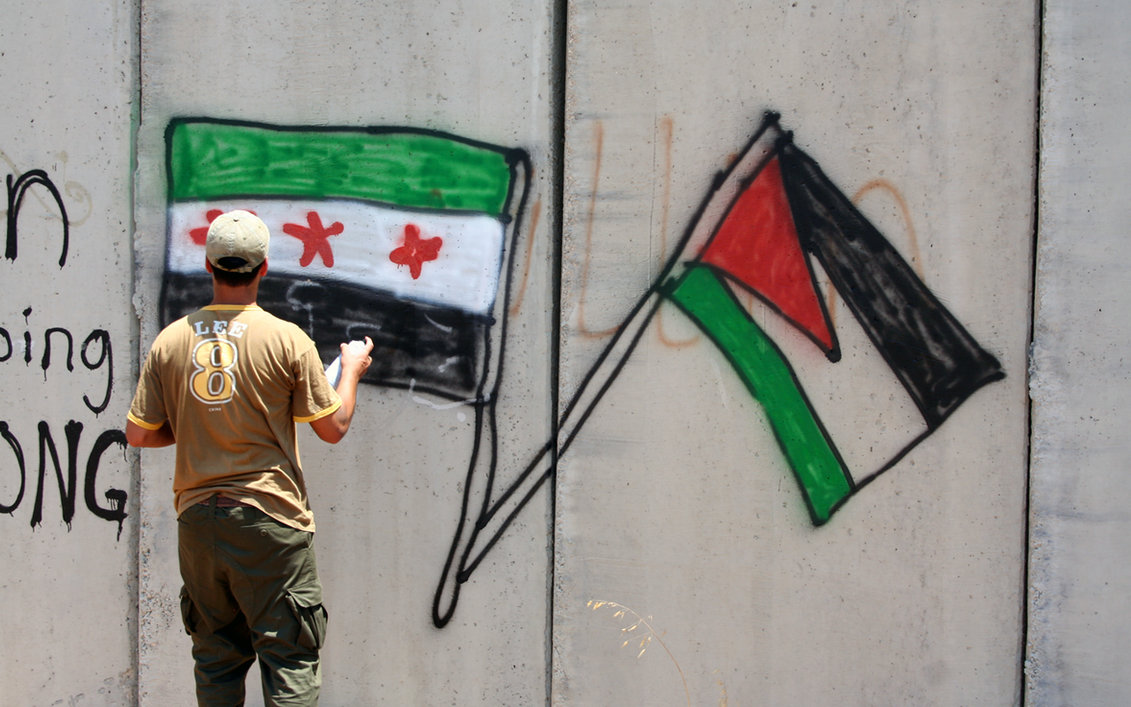
The Intersectional Syria website has issued a “Statement of Free Syrians in Solidarity with the Palestinian People,” opening: “We, Syrians united in the revolutionary struggle against the Assad regime and its imperialist sponsors, stand firmly and unequivocally with the Palestinian people in Gaza, the West Bank and across historic Palestine, in their fight for liberation from Israeli colonisation, occupation and apartheid.” In addition to drawing parallels between bombardment and repression by Israel and the Bashar Assad dictatorship, the statement emphasizes the historical and cultural links between the Syrian and Palestinian peoples—and accuses the Assad regime of hypocritically exploiting the Palestinian cause in rhetoric while betraying it in actual deeds:
Our solidarity is rooted in our inherent humanity and shared culture, history and heritage. Prior to the British and French occupations and advent of the modern nation states within Sykes-Picot borders, the peoples of bilad ash-sham were closely connected. Since the expulsion of Palestinians from their lands in 1948, we Syrians have adopted the Palestinian cause as our own. This has been reflected in our poetry, music, civic discourse and armed resistance. Syrians welcomed Palestinian refugees as they arrived in our cities, and Palestinians in Syria became embedded within the fabric of our society.
Whilst the Syrian people have always stood with the Palestinian cause, the Assad regime has used it as a rhetorical tool which, far from liberating Palestine, has instead led to increased oppression within Syria’s borders.
During the 1967 war, as defence minister, Hafez al-Assad ordered the Syrian army to retreat from the Golan Heights before any Israeli troops had arrived. The Syrian Golan has been subject to brutal Israeli occupation and colonisation, severed from the Syrian homeland and intentionally marginalised by the Assad regime and wider region. The Golan Heights remain confined by Israeli colonisation, the genocidal Assad regime and geo-political schemes.
When the Lebanese civil war erupted, Hafez al-Assad loudly declared Syria’s support for the Palestinian-Muslim-Leftist alliance against the pro-Israel Falangists. But when the Falangists appeared at risk of defeat in 1976, Assad ordered the Syrian army to intervene against the pro-Palestinian alliance. The Assad regime slaughtered up to 1500 Palestinian civilians in camps in Lebanon, most notably at Tel Za’atar.
At home, the regime declared a State of Emergency which suspended Syrians’ political and civil rights in the name of resistance to Israel, all the while carefully protecting the false border with the occupied Golan Heights. Both Syrians and Palestinians were arrested if they dared take any cultural, political or military initiative against the Israeli occupation. One case is that of Tal al-Mallouhi, a Syrian teenager who blogged in support of Palestine. She wrote articles and poems which encouraged Syrians, Arabs and Muslims to do more to help Palestinians. For this ‘crime’, the Assad regime threw her in prison in 2009. She remains in prison today.
When our revolution erupted, Syrians and Palestinians in Syria stood shoulder to shoulder. We worked together to supply food and medicine to besieged communities, to organise strikes and marches, and to build democratic alternatives to the murderous regime.
Because Palestinians and Syrians stood together for freedom and dignity, the Assad regime attacked Palestinian camps as fiercely as it assaulted Syrian cities. The Palestinian camp in Daraa and the Raml camp in Lattakia were among those bombed and besieged.
The Yarmouk camp, on the outskirts of Damascus, was known as ‘the capital of the Palestinian diaspora’. Its residents initially adopted a position of neutrality in the revolution, but for many that changed in May 2011 when the regime encouraged Palestinians to demonstrate on the Golan border to commemorate the Nakba and then failed to intervene as youth were shot and killed by Israeli soldiers. In December 2012, the Abdul Qadir Al Husseini mosque, was shelled by regime warplanes, killing many of the internally displaced people who were sheltering inside. A five-year siege was imposed on the camp and residents were subjected to slow starvation and a lack of essential supplies. Comparisons were made at the time with the brutal Israeli (and Egyptian) imposed siege on Gaza. Following intense bombardment in April 2018 which destroyed much of the camp’s infrastructure, families were forcibly displaced, for many this was a second Nakba. Scores are now prevented from returning, as their homes have been expropriated under new ‘development’ plans from which regime loyalists benefit – despite the objections of former residents.
Bilad ash-sham, literally “Land of the Levant,” is the historical name for Syria, which in ancient times included Palestine. During the years of siege and bombardment, the population of the Yarmouk camp was reduced from 160,000 to 6,000, according to the UN agency for Palestine refugees, UNRWA.
Signatories of the statement inlcude prominent Syrian left-dissidents such as Robin Yassin-Kassab and Leila Al Shami (co-authors of Burning Country: Syrians in Revolution and War), Yassin Haj Saleh (author of Impossible Revolution: Making Sense of the Syrian Tragedy), “rendition” victim Maher Arar, and New York-based activist Shiyam Galyon.
Photo of man painting Palestinian and Syrian flags on the West Bank separation wall, via Intersectional Syria




